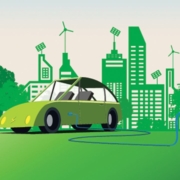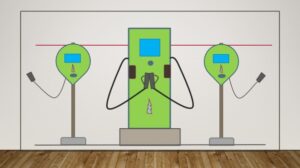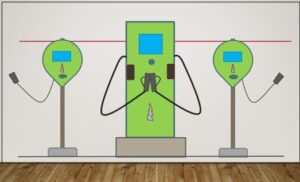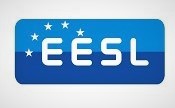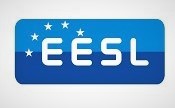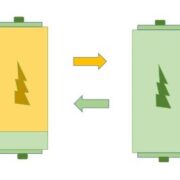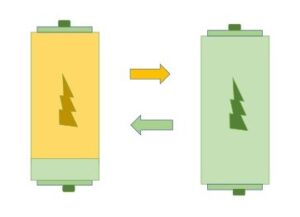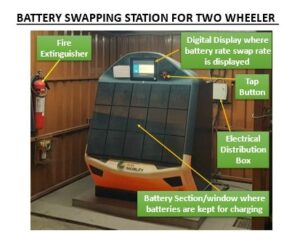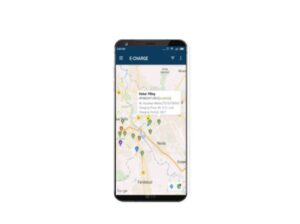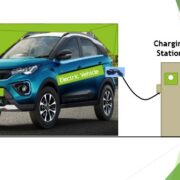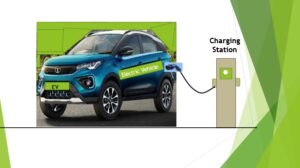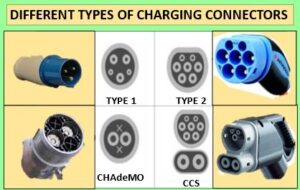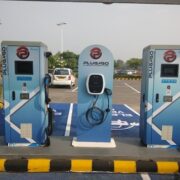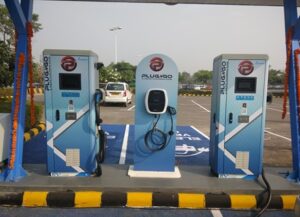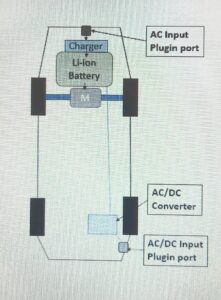EV Policy in India
EV Policy in India
As per guidelines issued by Ministry of Power dated 14th Jan,22 regarding “Charging infrastructure for Electric Vehicles (EV) – The revised consolidated Guidelines & Standards – reg”, some of the key points are given below –
Definitions –
- Electric Vehicle Supply Equipment (EVSE) – shall mean an element in Electric Vehicle Charging Infrastructure (EVCI) that supplies electrical energy for recharging the battery of electric vehicles.
- Public Charging Stations (PCS) – shall mean an EV charging station where any electric vehicle can get its battery recharged.
- Battery Charging Stations (BCS) –shall mean an station where the discharged or partially discharged electric batteries for electric vehicles are electrically discharged.
- Captive Charging Stations (CCS) – shall mean an electric vehicle charging stations exclusively for electric vehicles owned or under the control of owner of the charging station e.g. Government department, corporate houses Bus Depots, charging station by owned by the fleet owners etc. and shall not be used for commercial purpose of charging other vehicles on paid for basis.
- Battery Swapping Stations (BSS) – shall mean a station where any electric vehicle can get its discharged battery or partially discharged battery replaced by a charged battery.
Guidelines –
- Owners may charge their vehicle at their residence/office using their existing electricity connection.
- Any individual / entity is free to set up public charging stations provided that such station can meet the technical, safety as well as performance standards & protocols laid down as well as norms/standards/specifications laid down by the Ministry of Power, Bureau of Energy Efficiency (BEE) and Central Electricity Authority (CEA) from time to time.
- 2.1 Public Charging Stations (PCSs) may apply for electricity connection & Distribution Company Licensee shall release connection for EV Public Charging Stations in accordance with the timelines stated in section 4 sub. (11) of the Electricity (Rights of Consumers) Rules 2020.
- 2.2 Any public charging stations /chain of charging stations may obtain electricity from any generation company through open access. Open access shall be provided for this purpose within 15 days of receipt of the application complete in all respect.
-
3. Public Charging Infrastructure (PCI)
– Requirements:
- 3.1 Every PCS will comply with following-
- i. An exclusive with all related substation equipment including safety appliance, if required by Supply Code as approved by appropriate Electricity Regulation Commission.
- ii. Appropriate civil works
- iii. Appropriate cabling & electrical works ensuring safety
- iv. Adequate space for charging & entry/exit of vehicles.
- v. Appropriate fire protection equipment & facilities,
- vi. PCS shall have any one or more chargers or any combination of chargers.
- vii. Charging station for (two/three wheelers) e-vehicles shall be free to install any charger other than those specified above subject to compliance of technical & safety standards as laid down by CEA.
- viii. Tie up with at least one online Network Service Provider to enable advance remote/online booking of charging slot by EV owners. Such online information to EV owners should also include information regarding location, types & number of chargers installed/available, services charges for charging etc.
- ix. Share charging station data with appropriate State Nodal Agency (SNA) & adhere to protocols as prescribed by Central Nodal Agency (CNA) i.e BEE for this purpose. The SNA & CAN shall have access to this data.
- 3.2 Electric Vehicle Supply Equipment (EVSE) should have been type tested by an agency/lab accredited by ny National Accreditation Board for Testing Calibration Laboratories (NABL) from time to time.
- 3.3 The above minimum infrastructure requirements doesn’t apply to private charging points meant for self-use of individual EV owners (non-commercial owners).
- 3.4 Captive charging infrastructure for 100% internal use for a company’s own/leased fleet for its own use will not be required to install chargers as per para 3.1 & to have Network Service Provider (NSP) tie ups.
- 3.5 Public Charging Station may also be installed by housing societies, Malls, office Complexes, Restaurants, Hotels etc. with a provision to allow charging of visitor’s vehicles which are permitted to come in its premises.
-
4. Public Charging Infrastructure (for long range EVs) and/or heavy-duty EVs:
- 4.1 Fast Charging Stations (FSC) i.e. public charging stations for long range EVs) and/or heavy duty EVs (like trucks, buses etc) will have the following –
- i. At least two chargers of minimum 100 KW (200- 750 V or higher) each of the different specifications (CCS/CHAdeMO chargers for above capacity or BIS Standard for e-Bus Charging Station (Level-4: 250 – 500KW) as provided under Annexure III (6)) with single connector gun each.
- ii. Appropriate Liquid Cooled Cables for high speed charging facility as above 4.1(i), for onboard charging of Fluid Cooled Batteries (currently available in some long range EVs), if required.
- 4.2 Such Fast Charging Stations (FCS) which are meant for 100% in house/captive utilization, for example buses of a company, wood be free to decide the charging specification as per requirement for its in-house company EVs.
-
5. Location Public Charging Stations:
- 5.1 In case of Public Charging Stations, the following requirements are laid down with regard to density /distance between two charging points:
- i. At least one charging station shall be in a grid of 3Km x 3Km. Further, one charging station shall be set up by at every 25Km on both sides of highways/roads.
- ii. For long range EVs and/or heavy duty EVs like buses/trucks etc, there shall be at least one Fast Charging with Charging Infrastructure Specifications as per para 4.1 above at every 100 Km, one on each side of highways/roads located preferably within/alongside the public charging stations. Within cities, such charging facilities for heavy duty EVs may be located within Transport Nagars, bus depot.
- 5.2 Additional PSC/FCS can be installed even if there exists a PSC/FCS in the required grid or distance.
-
Database of Public EV Charging Stations:
- 6.1 Bureau of Energy Efficiency (BEE) shall create & maintain a national online database of all the public charging stations in consultation with State Nodal Agency (SNAs). BEE shall create a web portal/software/Mobile Application for the database of Public Charging Stations throughout the country.
-
Tariff of supply of electricity to EV Public Charging Stations:
- 7.1 The tariff of supply of electricity to EV Public Charging Stations shall be a single part tariff and shall not exceed the “Average Cost of Supply” till 31st March, 2025. The same tariff shall be applicable for Battery Charging Stations (BCS).
- 7.2 The tariff applicable for domestic consumption shall be applicable for domestic charging.
- 7.3 The separate metering arrangement shall be made for PCS so that consumption may be recorded & billed as per applicable tariff for EV Charging Stations.
-
Service Charges at PCS –
- 8.2 Charging of EVs is a service as already clarified by Ministry of Power vide letter no-23/08/2021 -R&R dated 13.04.2018.
- 8.1 As electricity is being provided at concessional rates and also considering the fact that subsidy is being provided by the central/state govt in many cases for setting up Public Charging Stations, the State Govt shall fix the ceiling of Service Charges to be charged such PCS/FCS.
Electric Vehicle Chargers as provided under Para 3.1 (vi) of the Guidelines
| Type of Charger | Type of Charger Connectors | Rated Output Voltage | No of Connector Guns | EV Type |
| Slow/Moderate | Bharat DC -001 (15 KW) | 48 | 1 CG | 4-Wheeler, 3-Wheeler, 2-wheeler |
| Bharat DC -001 (15 KW) | 72 or higher | 1 CG | 4-Wheeler | |
| Bharat AC -001 (10 KW) | 230 | 3 CG of 3.3 KW each | 4-Wheeler, 3-Wheeler, 2-wheeler | |
| Fast | Type-2 AC (min 22KW) | 380-415 | 1 CG | 4-Wheeler, 3-Wheeler, 2-wheeler |
| CHAdeMO (min. 50 KW) | 200-500 or higher | 1 CG | 4-Wheeler | |
| CCS (min. 50KW) | 200-750 or higher | 1 CG | 4-Wheeler | |
| Specification as per E-mobility I BEE | ||||
Indian Standards EV Charging notified by BIS of 01.11.2021
Light EV AC Charge Point
| Power Level 1 | Charging Device | EV-EVSE
Communication |
Charge Point Plug Socket | Vehicle Inlet/ Connector |
| Up to 7Kw | IS -17017-22-1 | Bluetooth
Low Energy |
IS -60309 | As per EV Manufacturer |
-
Light EV DC Charge Point
| Power Level 1 | Charging Device | EV-EVSE
Communication |
Charge Point Plug Socket | Vehicle Inlet/ Connector |
| Up to 7Kw | IS -17017-25 | Combined socket under development | IS -17017-2-6 | |
-
Parkbay AC Charge Point
| Power Level 2 | Device /Protocol | EV-EVSE
Communications |
Infrastructure Socket | Vehicle Connector |
| Normal Power -11Kw/22Kw | IS -17017-1 | IS-15118 (PLC) for Smart Charging | IS -17017-2-2 | IS -17017-2-2 |
-
Parkbay DC Charge Point
| Power Level 2 | Device /Protocol | EV-EVSE
Communication |
Infrastructure Socket | Vehicle Connector |
| Normal Power -11Kw/22Kw | IS -17017-23 | IS-17017-24 (CAN)
IS-15118 (PLC) |
IS -17017-22-2 | IS -17017-2-3 |
-
DC Charge Protocol
| Power Level 3 | Charging Devise | EV-EVSE
Communication |
Connector |
| DC 50Kw to 250Kw | IS -17017-23 | IS-17017-24 (CAN)
IS-15118 (PLC) |
IS -17017-2-3 |
-
eBus Charging Station (Level-4: 250-500 Kw)
| Power Level 4 | Charging Device | EV-EVSE
Communication |
Connector |
| DC High Power (250 Kw to 500Kw) | |||
| Dual Gen Charging Station | IS -17017-23-2 | IS-15118 (PLC) | IS -17017-2-3 |
| Automated Pantograph Charging Station | IS -17017-3-1 | IS -17017-3-2 |

